Sensō-ji Temple, Tokyo
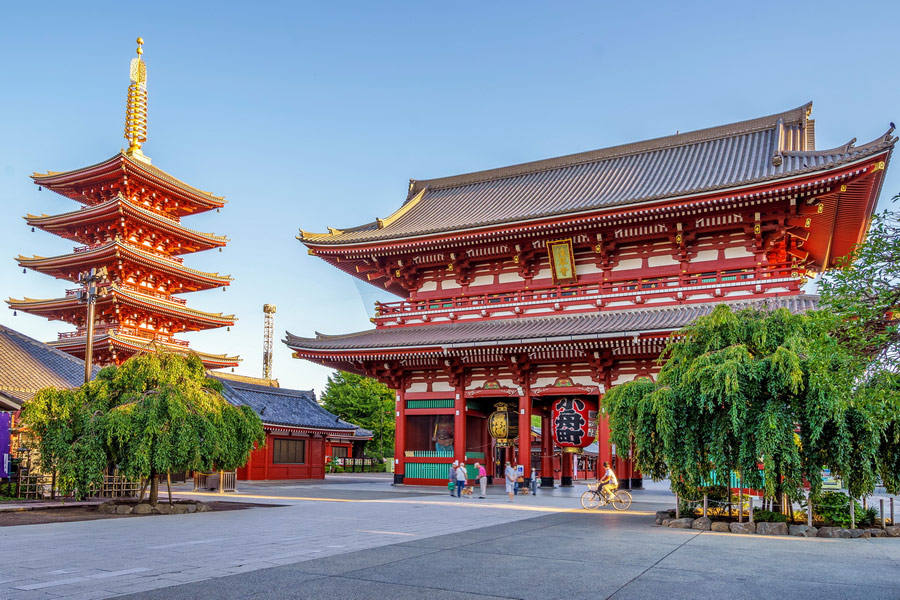
Sensō-ji Temple (浅草寺), also known as Kinryū-zan Sensō-ji (金龍山浅草寺) or Asakusa Kannon (浅草観音), is the oldest Buddhist temple in Tokyo. Located in the historic Asakusa district, it is dedicated to Kannon, the bodhisattva of compassion. Sensō-ji ranks among the most visited temples in Japan and holds a special place as one of Tokyo’s key spiritual landmarks.
How to Get to Sensō-ji Temple
Address: 2 Chome-3-1 Asakusa, Taito City, Tokyo 111-0032, Japan
Sensō-ji Temple is conveniently located in central Tokyo and can be easily reached on foot from several nearby train stations. The closest access points are Asakusa Station on the Ginza Line, Toei Asakusa Line, and Tobu Skytree Line, as well as Asakusa Station on the Tsukuba Express. From any of these stations, the walk to the temple takes approximately five minutes. Clear signage and the steady flow of visitors make the route simple and direct. The nearby Tokyo Skytree, one of the tallest towers in the world, also serves as a useful point of reference and is a popular additional stop for travelers exploring the Asakusa area.
History of Sensō-ji Temple
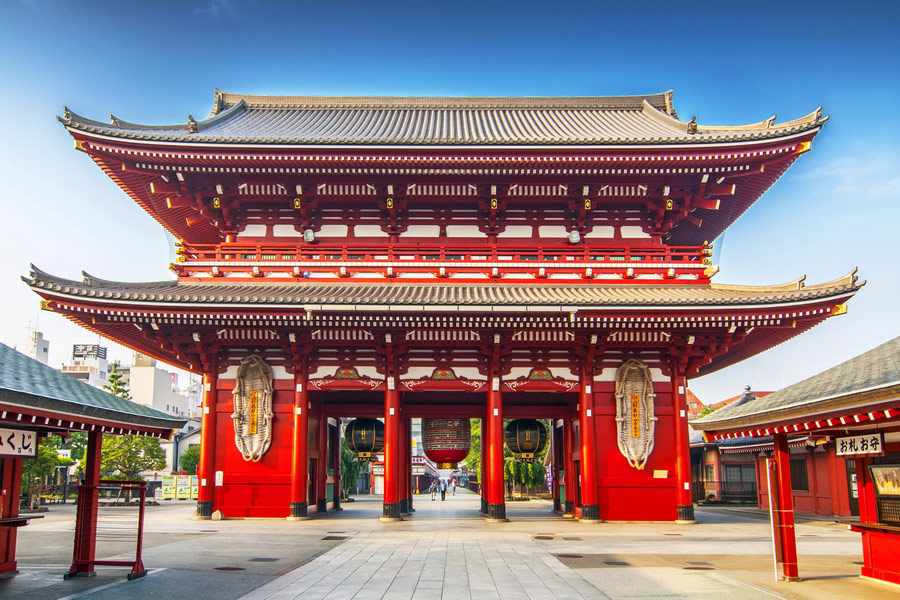
According to legend, in the year 628, two fishermen pulled a statue of the bodhisattva Avalokiteshvara from the Sumida River. No matter how many times they tried to return it to the water, the statue kept coming back to them. The village elder recognized the figure as Kannon, the goddess of mercy, and dedicated his home to her veneration.
In 645, the Buddhist monk Shokai enshrined the statue and hid it from view, where it has remained ever since – visible only to spiritual eyes, as tradition holds.
Thanks to the temple, the small fishing village of Asakusa began to thrive. During the Kamakura period (1185–1333), Sensō-ji came under the patronage of the ruling shoguns. In 1590, Tokugawa Ieyasu designated it as the official temple of the Tokugawa shogunate. From that point on, devotion to Kannon spread widely across Japan, especially during the Edo period (1603–1867).
Kannon: The Goddess of Mercy
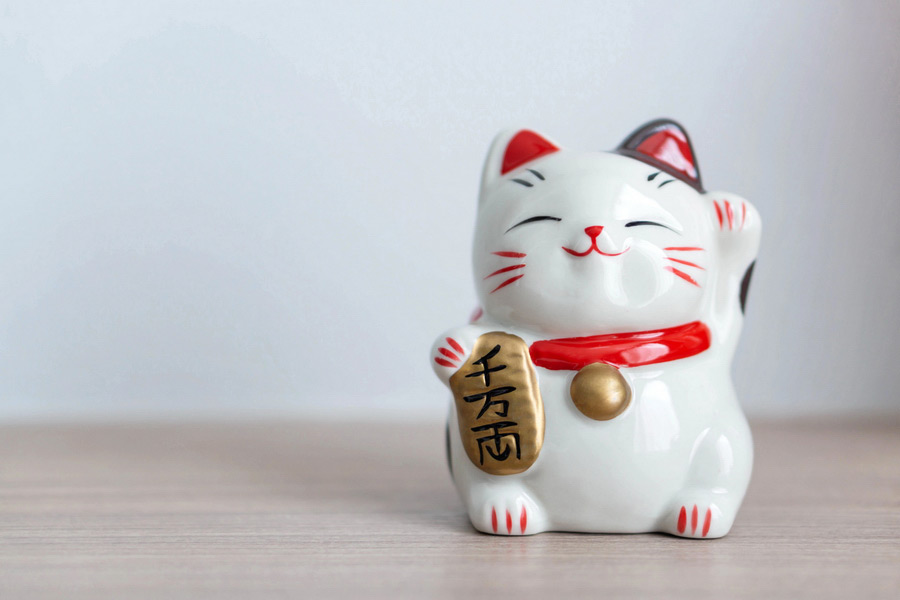
Kannon is the embodiment of compassion in Japanese Buddhism. Her worship was introduced to Japan from China, where she is known as Guan Yin, and originally stems from the Indian bodhisattva Avalokiteshvara. In Japanese tradition, Kannon is said to take on 33 different forms to aid anyone in need, regardless of their background or belief.
She is often depicted with many hands, symbolizing her ability to help countless people at once and respond to the suffering of the world.
One popular legend associated with Kannon is linked to the maneki-neko – the iconic “beckoning cat” good luck charm. According to the story, a monk and his cat took shelter during a thunderstorm and encountered a lost samurai. The cat’s raised paw guided the samurai to safety. In gratitude, the warrior made a generous donation that saved the temple from financial ruin. This tale gave rise to the belief that the maneki-neko brings prosperity and protection.
What to See at Sensō-ji Temple
Sensō-ji Temple is home to several iconic buildings and sites, each with its own unique significance and architectural value.
The Main Hall (本堂) consists of two parts: the inner sanctum (naijin) and the outer sanctum (gejin). It is here that the statue of the goddess Kannon is enshrined, hidden from the eyes of visitors. Her image remains a mystery even to the temple monks, but it is to her that pilgrims direct their prayers.
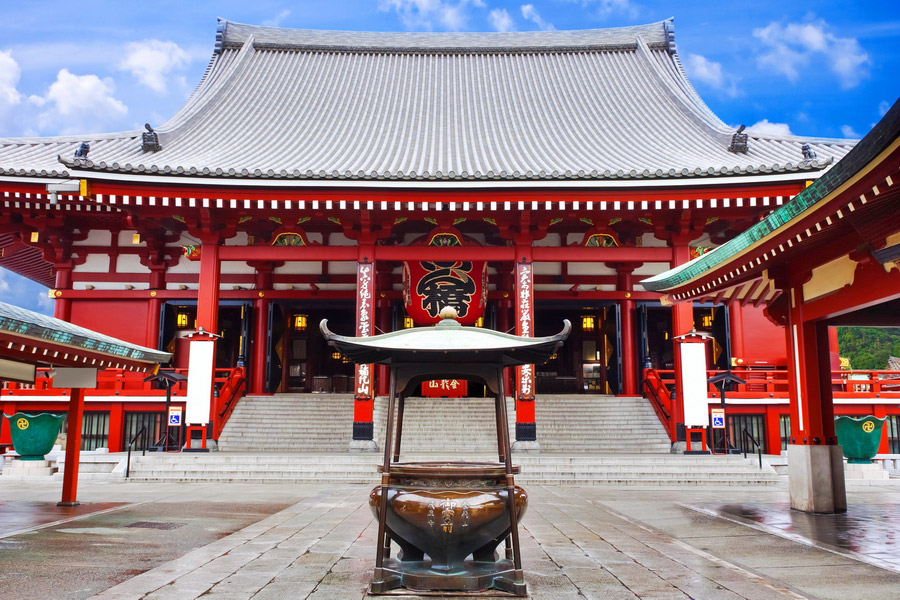
Yogodō Hall is dedicated to eight Buddhas, each associated with one or two animals of the Chinese zodiac. It is believed that the corresponding Buddha offers protection to those born under that particular sign.
Awashimadō Hall, built during the Genroku period (1688–1704), honors the deity Awashima Myōjin, who was transferred here from a temple in Kada, Wakayama Prefecture. The hall is recognized as an important cultural heritage site and reflects the continuity of Japan’s spiritual traditions.
The Five-Storied Pagoda (五重塔) was originally built in 1648 and restored in 1973. It symbolizes the five elements of Buddhist cosmology – earth, water, fire, wind, and sky. Sacred relics of the Buddha, given to the temple as a spiritual gift, are enshrined at its summit.
Denbōin and the adjacent Denbōin Garden include several historical rooms such as the reception hall (Kyakuden), antechamber, library, and study spaces. The Kyakuden was traditionally used for ascetic practices and memorial services. The garden, which is not open to the public, was designed by landscape master Enshū Kobori during the early Edo period.
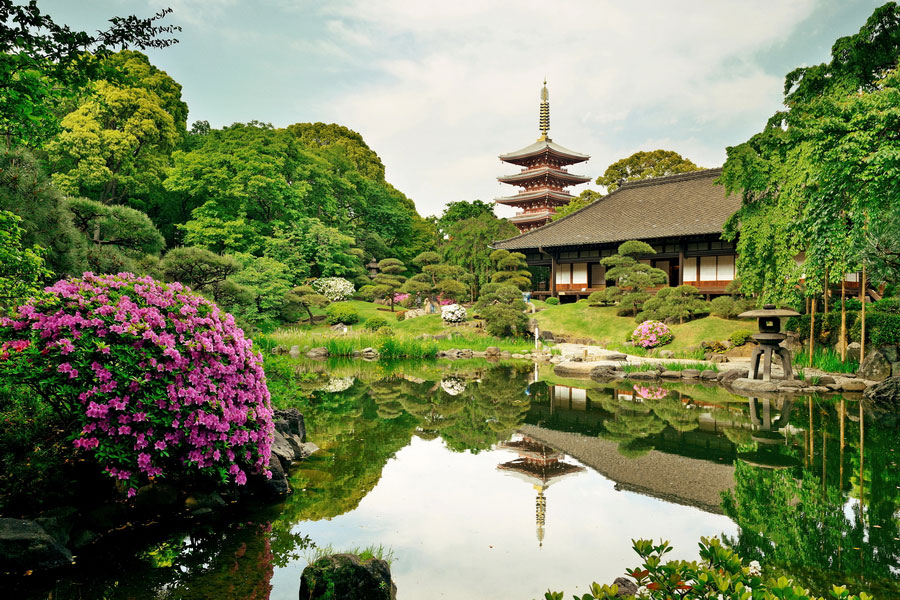
Niten-mon Gate, the eastern gate leading to the main altar of the temple, was originally constructed in 1618 as part of the Toshogu Shrine. It is an important cultural property, and after a major fire in 1642, it was the only part of the complex to survive.
Hōzō-mon Gate serves as the inner gate and features two statues of Nio, the traditional guardians, as well as a large central lantern. The gate was formerly known as Nio-mon but was later rebuilt to include a relic chamber, earning it the name Hōzō-mon, or “treasury gate”.
Kaminari-mon Gate (雷門) is the temple’s most iconic structure, easily recognized by its massive red lantern. Originally built in 942 by the warlord Taira no Kinmasa, the gate is flanked by statues of the wind god Fujin and the thunder god Raijin – deities believed to protect the temple from natural forces.
Nakamise Shopping Street stretches 250 meters between Kaminarimon Gate and the temple’s main building. Along this historic route are dozens of shops selling traditional Japanese sweets, snacks, souvenirs, and handcrafted items.
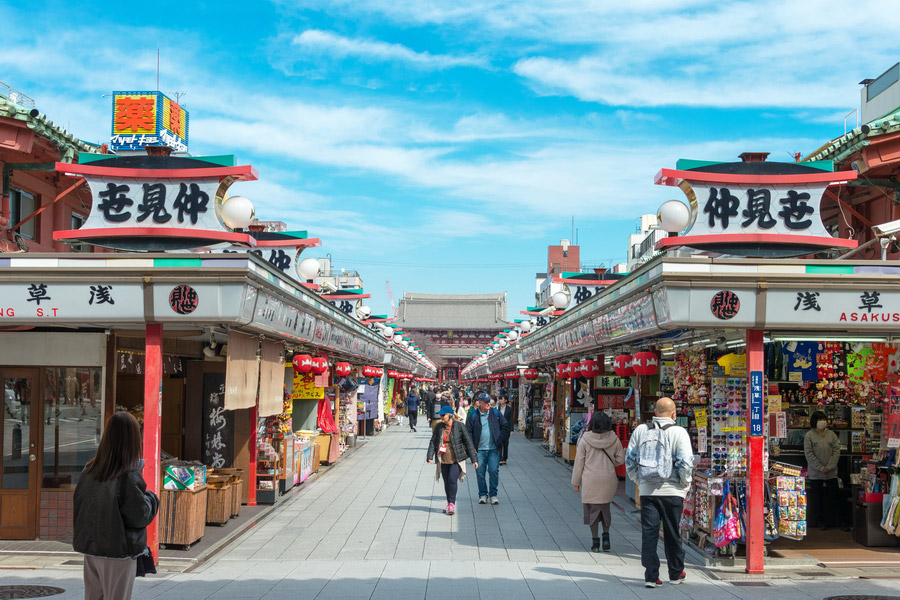
Bentendō Hall is dedicated to the goddess Benzaiten, the Japanese manifestation of Saraswati. It houses one of the three most revered statues of Benzaiten in the Kanto region and remains an active site of worship.
Annual Events
Sensō-ji Temple is the site of several annual events that reflect the deep spiritual and cultural traditions of Japan. Hatsumōde, held from January 1 to 7, marks the first visit to the temple in the new year. In early February, Setsubun is celebrated with a traditional bean-throwing ritual meant to ward off evil spirits. On March 18, Honzon Jigen-e commemorates the appearance of Kannon in the year 628. Hana Matsuri, celebrated on April 8, marks the birthday of the Buddha. One of the most spiritually significant observances, Shiman-rokusen-nichi on July 9 and 10, is believed to multiply the effect of prayers by 46,000 times. The final festival of the year, Osame-no-Kannon Goennichi, takes place from December 17 to 19 and is accompanied by the festive Hagoita Fair.
Visiting Tips
Before entering the temple, visitors are encouraged to purify themselves by washing their hands and mouth at the ritual spring. Quiet, respectful behavior is appreciated throughout the grounds. Photography and videography are permitted in areas where there are no posted restrictions. The temple grounds take on a particularly atmospheric character in the evening, when the soft glow of lanterns casts a gentle light and evokes a sense of serenity and reflection.
Opening Hours
The Main Hall is open from 6:00 to 17:00 between April and September, and from 6:30 to 17:00 between October and March. The temple courtyard remains open 24 hours a day. Entry to the temple grounds is free of charge.
Sensō-ji Temple is not only a spiritual symbol of Tokyo, but also a cultural landmark that preserves the architecture, legends, and religious practices of Japan. A visit to the temple offers more than sightseeing – it is an invitation to connect with the country’s heritage and experience its soul through tradition, nature, and the gentle light of lanterns in the quiet evening air of Asakusa.

